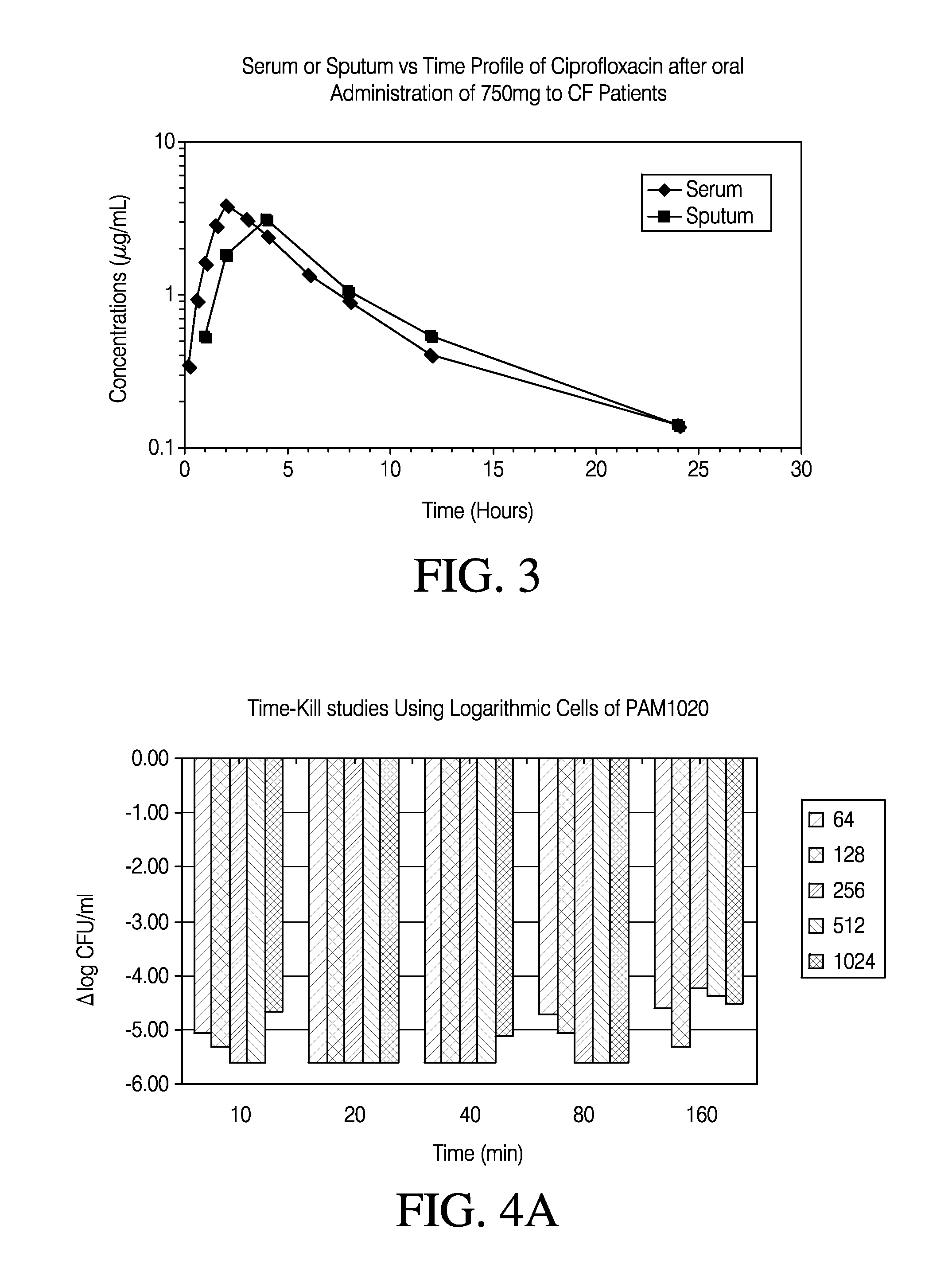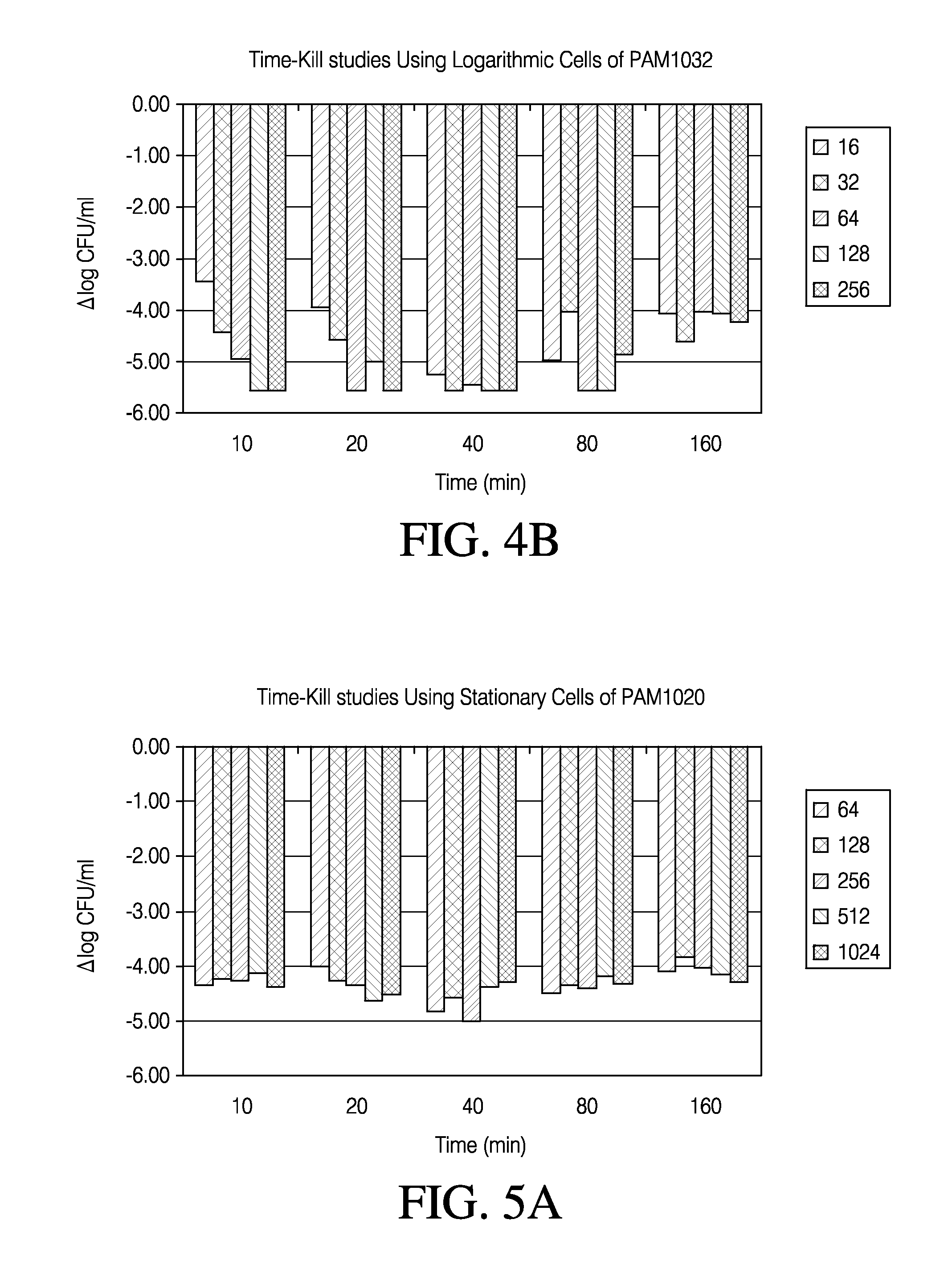Aerosolized fluoroquinolones and uses thereof
a fluoroquinolone and aerosol technology, applied in the field of aerosolized fluoroquinolones, can solve the problems of threatening the clinical utility of even the most aggressive antibacterial therapy, higher morbidity and mortality, and long patient hospitalization, so as to prevent further resistance, overcome resistance, and overcome resistance.
- Summary
- Abstract
- Description
- Claims
- Application Information
AI Technical Summary
Benefits of technology
Problems solved by technology
Method used
Image
Examples
example 1
High Local Concentration with Short Duration Aerosol Fluoroquinolone Exposure
[0277]Aerosol administration of fluoroquinolones such as levofloxacin produces high concentrations in the epithelial lining fluid (ELF) of rats and humans. However, this dose has been observed to rapidly decline following administration.
[0278]In order to determine if short duration, high concentrations of levofloxacin could be effective in treatment of P. aeruginosa (PA), studies were conducted to measure their bactericidal activity on various strains of this organism which were grown at different conditions. Those were chosen based on what is known about conditions and growth of PA in a cystic fibrosis (CF) lung. Four isogenic strains of P. aeruginosa were used for these experiments (Table 2).
TABLE 2Strains of PA Used in Time-Kill Experiments.Levofloxacin MICStrainGenotype(ug / ml)PAM1020wt0.25PAM1032nalB1
[0279]PAM1020 is the parent wild-type strain, PAM1032 contains nalB mutation which results in increased ...
experiment 1
Activity of Levofloxacin Against Exponentially Grown Cells
[0280]Methods
[0281]Inoculum Preparation
[0282]Strains were grown aerobically overnight in Mueller-Hinton Broth (MHB) at 35° C. Next, cultures were diluted 1:1000 into 100 ml of fresh MHB and grown to OD600˜0.3 to reach CFU / ml ˜108. 10 ml of this culture was moved to 50 ml flasks, each containing 10 ml of pre-warmed MHB broth with appropriate concentrations of levofloxacin (2× as compared to the exposure concentrations).
[0283]Exposure
[0284]All strains were treated for 10 min., 20 min., 40 min., 80 min. and 160 minutes. The following concentrations of levofloxacin (ug / ml) were used for the exposure of PAM1020 and PAM1032: 16, 32, 64, 128 and 256. All strains were treated at each concentration for 10 min., 20 min., 40 min., 80 min. and 160 minutes.
[0285]Determination of Viable Cell Numbers
[0286]At appropriate times, 1 ml of each exposure culture was centrifuged for 2 minutes, the pellet was washed twice with 1 ml of drug-free MHB...
experiment 2
Activity of Levofloxacin Against Stationary Phase Cells
[0288]Methods
[0289]Inoculum Preparation
[0290]Strains were grown aerobically overnight in Mueller-Hinton Broth (MHB) at 35° C. (350 ml total). The spent medium was obtained after centrifugation of overnight cultures and filtering the supernatant. Cultures were diluted to OD=0.3 into spent medium. The same medium was also used to prepare antibiotic concentrations (the same as in Experiment 1).
[0291]Exposure
[0292]Antibiotic concentrations, time of exposure as determination of viable cell counts were the same as in Experiment 1.
[0293]Results
[0294]Cell numbers at initiation of antibiotic exposure are shown in Table 4.
TABLE 4Bacterial Numbers at Time of Initial Bacterial Exposure.StrainCFU / mlPAM1020 8.0E+08PAM10328.50E+08
[0295]For stationary phase cells of PAM1020, maximum killing was observed at the lowest concentration corresponding to 64-fold above MIC (16 ug / ml) and the shortest duration of exposure, 10 minutes (FIG. 5A). However,...
PUM
| Property | Measurement | Unit |
|---|---|---|
| mass median aerodynamic diameter | aaaaa | aaaaa |
| mass median aerodynamic diameter | aaaaa | aaaaa |
| mass median aerodynamic diameter | aaaaa | aaaaa |
Abstract
Description
Claims
Application Information
 Login to View More
Login to View More - R&D
- Intellectual Property
- Life Sciences
- Materials
- Tech Scout
- Unparalleled Data Quality
- Higher Quality Content
- 60% Fewer Hallucinations
Browse by: Latest US Patents, China's latest patents, Technical Efficacy Thesaurus, Application Domain, Technology Topic, Popular Technical Reports.
© 2025 PatSnap. All rights reserved.Legal|Privacy policy|Modern Slavery Act Transparency Statement|Sitemap|About US| Contact US: help@patsnap.com



